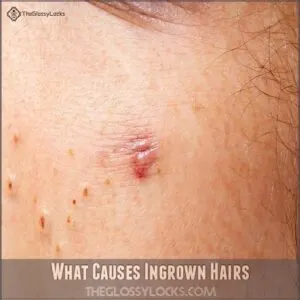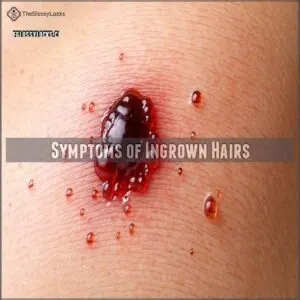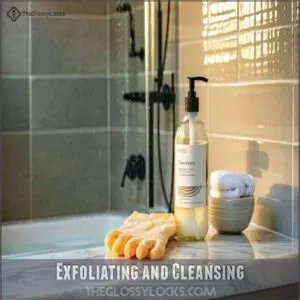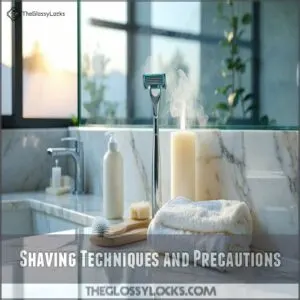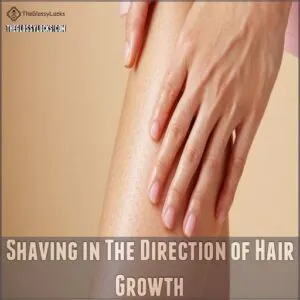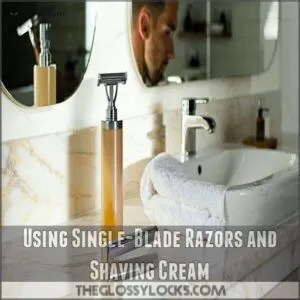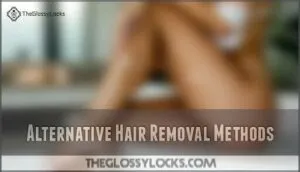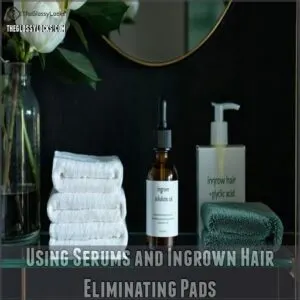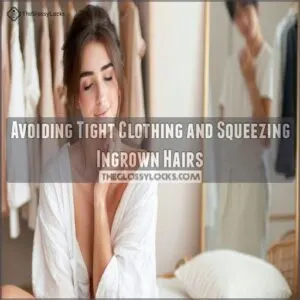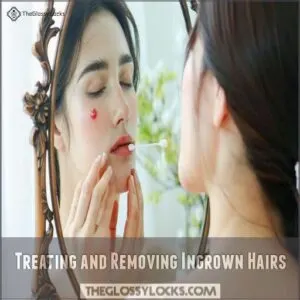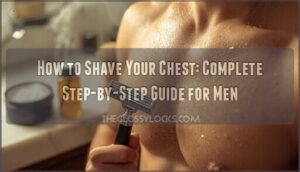This site is supported by our readers. We may earn a commission, at no cost to you, if you purchase through links.
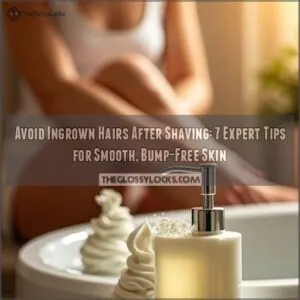 To avoid ingrown hairs after shaving, start by prepping your skin with warm water to soften the hair and open pores. Use a sharp, clean single-blade razor and shave in the direction of hair growth—fewer strokes, less irritation.
To avoid ingrown hairs after shaving, start by prepping your skin with warm water to soften the hair and open pores. Use a sharp, clean single-blade razor and shave in the direction of hair growth—fewer strokes, less irritation.
Slather on shaving cream (bonus points if it’s exfoliating) to keep things smooth and sleek. Try not to shave too close; leaving a bit of stubble can reduce the chances of hair curling back into your skin.
Afterward, hydrate with a light moisturizer and steer clear of tight clothes rubbing on freshly shaved areas. Curious about simpler grooming alternatives? Stay tuned!
Table Of Contents
- Key Takeaways
- What Causes Ingrown Hairs
- Symptoms of Ingrown Hairs
- Prevention Techniques for Ingrown Hairs
- Alternative Hair Removal Methods
- Post-Shaving Care for Ingrown Hairs
- Treating and Removing Ingrown Hairs
- Frequently Asked Questions (FAQs)
- How do I stop ingrown hairs after shaving?
- Does moisturizing after shaving prevent ingrown hairs?
- How to stop picking ingrown hairs?
- Why do I get ingrown hairs when I shave down there?
- Can hormonal changes increase the risk of ingrown hairs?
- How does diet impact the occurrence of ingrown hairs?
- Are there any natural remedies for ingrown hairs?
- Conclusion
Key Takeaways
- Exfoliate and cleanse your skin regularly to remove dead cells and prevent trapped hairs.
- Always shave in the direction of hair growth using a sharp single-blade razor with shaving cream.
- Hydrate your skin with a light moisturizer after shaving to reduce irritation and keep it smooth.
- Avoid wearing tight clothing over freshly shaved areas to minimize friction and the risk of ingrown hairs.
What Causes Ingrown Hairs
You’ll often notice those pesky ingrown hairs when your freshly cut hair grows back into your skin instead of breaking through the surface.
If you have curly hair or frequently remove hair through shaving, waxing, or tweezing, you’re more likely to experience these uncomfortable bumps.
Hair Removal Techniques
Ever wondered why some hair removal methods leave you with more ingrown hairs than others? Your choice of technique plays a vital role in preventing those pesky bumps.
From threading risks to sugaring methods, each approach affects how your hair grows back.
- Depilatory creams dissolve hair at the surface, reducing sharp edges that lead to ingrowns
- Epilators pull hair from the root, potentially causing less frequent regrowth
- Electrolysis options provide permanent results but require professional treatment
- Threading can increase ingrown hair risk by breaking hair below the skin’s surface
Curly Hair and Ingrown Hairs
If you have curly hair, you’re more likely to get ingrown hairs – it’s just how your hair structure works.
Curly hair genetics play a big role in pseudofolliculitis barbae, especially in people with African ancestry. Here’s why your gorgeous curls might need extra care:
Your hair’s natural curl pattern means the sharp tip of freshly cut hair can easily curve back into your skin. Understanding these ingrown hair patterns helps prevent follicle damage.
| Hair Type | Risk Level | Common Areas | Prevention Tips |
|---|---|---|---|
| Tightly Coiled | Very High | Neck, Face | Use Electric Trimmer |
| Wavy | Moderate | Arms, Legs | Exfoliate Regularly |
| Spiral Curls | High | Bikini Line | Try Chemical Hair Removal |
| Loose Curls | Medium | Underarms | Keep Hair Longer |
Skin Folds and Scars
Two common ingrown hair triggers lurk in your skin folds and scars.
When you shave areas with scar tissue buildup, the altered skin texture can trap hair beneath the surface, leading to razor bumps. Similarly, skin creases naturally create pockets where follicle clog prevention becomes tricky.
To minimize skin irritation, focus on improving skin elasticity and use gentle strokes when shaving these sensitive areas.
Types of Ingrown Hairs
Your body’s hair-removal adventures can lead to different types of ingrown hairs. Follicular ingrown hairs curl back into the same pore, while embedded hair strands tunnel into nearby skin.
Ingrown hairs can usually be treated at home by using warm compresses.
You might encounter inflamed hair pores that develop into ingrown hair cysts or abscesses. These variations of pseudofolliculitis barbae and razor bumps can range from mild irritation to more serious infections requiring medical attention.
Symptoms of Ingrown Hairs
You’ll notice those pesky ingrown hairs first as small, red bumps that feel tender and itchy where you’ve shaved.
These bumps can fill with pus and become infected if left untreated, leading to dark spots and possible scarring on your skin.
Redness and Inflammation
When ingrown hairs strike, they often leave your skin looking like a battlefield. The telltale signs of skin factors include redness and inflammation around hair follicles, creating angry-looking patches that can make you self-conscious.
To prevent such irritation, using an electric razor for ingrown hairs can substantially reduce the occurrence of ingrown hairs.
The symptoms of ingrown hairs often include:
- Warm, tender spots that feel like tiny bruises
- Red halos around each trapped hair
- Swollen bumps that look like mosquito bites
- Patches of irritated skin that feel hot to touch
- Raised areas with visible trapped hairs underneath
These inflammation symptoms typically appear within 24 hours after shaving, making sensitive skin solutions vital for ingrown hair prevention and razor burn relief.
Pain and Itching
Beyond the visual signs, ingrown hairs often cause significant discomfort.
That persistent itch might make you want to scratch, while sharp, stinging pain can make everyday movements uncomfortable. Most people describe the sensation as similar to a mosquito bite that won’t quit.
For quick relief from these symptoms, try applying a cold compress or over-the-counter hydrocortisone cream to soothe skin irritation and reduce ingrown hair pain.
Bumps and Pus-Filled Bumps
Those pesky ingrown hairs often reveal themselves as angry red bumps or pus-filled pustules on your skin. These bumps can make everyday activities uncomfortable.
They can vary in size and severity, ranging from tiny spots to painful cystic ingrown hairs.
- Small red bumps might appear within 24 hours of shaving, signaling trapped hair beneath the skin
- Infected bumps can develop white or yellow pus, indicating a bacterial infection
- Cystic ingrown hairs form deeper under the skin, creating larger, more painful bumps that may need professional treatment
Hyperpigmentation and Scarring
Struggling with ingrown hairs can leave lasting marks on your skin.
You’ll notice dark spots (hyperpigmentation) and sometimes permanent scars, especially if you’ve picked at the bumps.
Here’s what different types of skin damage look like:
| Type | Appearance | Duration |
|---|---|---|
| Dark spots | Brown/black patches | 3-6 months |
| Keloid scars | Raised, pink lumps | Permanent |
| Surface marks | Flat, red spots | 1-2 months |
Prevent these changes through proper ingrown hair prevention and early treatment.
Prevention Techniques for Ingrown Hairs
You’ll be glad to know that preventing those pesky ingrown hairs isn’t as tricky as you might think.
With the right shaving techniques and proper skin preparation, you can keep your skin smooth and bump-free while avoiding the discomfort of ingrown hairs.
Exfoliating and Cleansing
Getting rid of dead skin cells is your first line of defense against pesky ingrown hairs.
Start your cleansing routine with gentle exfoliants like a loofah or exfoliating glove twice weekly. Natural cleansers help maintain your skin’s pH balance while removing debris that can trap hair beneath the surface.
For sensitive areas, opt for chemical exfoliation using products with salicylic acid to prevent irritation.
Shaving Techniques and Precautions
Now that your skin is prepped, let’s nail those shaving techniques to keep those pesky ingrowns at bay.
Hold a hot towel against your face before shaving, or hop in for a quick shower first. Keep your razor sharp and squeaky clean.
For the best blade sharpness maintenance, use a single-blade razor – it won’t tug or cut below the surface. Using a single-blade razor shaves at the surface, reducing ingrown hairs and razor bumps.
Apply shaving gel, never foam, to protect your skin.
Shaving in The Direction of Hair Growth
The direction of your shaving stroke makes all the difference in preventing ingrown hairs.
Think of hair mapping as your personal roadmap to smoother skin – following the natural flow of your follicle alignment reduces the chance of those pesky bumps.
Proper shaving angles and skin tension work together to guide your razor along the grain.
- Map your hair growth patterns by gently running your fingers across different areas
- Maintain light, consistent pressure while following the grain
- Take extra care around curves and contours where hair direction changes
- Pay attention to spots where growth patterns cross or swirl
Using Single-Blade Razors and Shaving Cream
While direction matters, your choice of razor and cream makes a huge difference.
Single-blade razors reduce the chance of hairs being cut too closely and growing back under your skin.
Opting for a shaving cream with ingredients like glycolic or salicylic acid, known for their exfoliating properties, can also help prevent ingrown hairs.
Apply a thick, moisturizing shaving cream in circular motions, giving it time to soften your hair.
Hold your razor at a 30-degree angle for the smoothest results without irritation.
Alternative Hair Removal Methods
If you’re tired of fighting those pesky ingrown hairs from shaving, you’ll be glad to know there are several effective alternatives.
These alternatives can give you smooth, bump-free skin. From gentle electric razors to long-lasting laser treatments, you can choose a hair removal method that works best for your skin type and lifestyle.
Electric Razors and Clippers
Modern electric razors and clippers offer a gentler approach for anyone struggling with ingrown hairs.
When selecting a clipper, it’s vital to take into account the best balding clippers for your specific hair type and needs.
Unlike traditional razors, adjustable trimmer settings on cordless electric shavers let you maintain a slight stubble, reducing the risk of hair growing back into your skin.
Many electric shaver reviews suggest keeping the hair just above skin level – it’s your sweet spot between smoothness and preventing those pesky razor bumps.
Waxing and Trimming
Waxing benefits include smoother results without sharp edges, reducing ingrown hairs.
Trimming tools, like electric trimmers, work well for shorter upkeep, especially in sensitive areas.
Prep your skin with exfoliation to remove dead cells and minimize irritation.
After wax or trim, an aftercare routine—moisturizing and applying soothing products—can keep bumps at bay.
Tweezers? Only for surface-level stray hairs!
Hair Removal Creams
Hair removal creams offer a painless solution, dissolving hair instead of cutting it.
They’re great for preventing ingrown hairs since there’s no sharp edge left behind.
Always follow cream application tips and patch-test first—skin sensitivity warnings aren’t there for nothing!
Pay attention to chemical ingredient concerns and opt for depilatory cream alternatives if irritation is an issue.
Laser and IPL Hair Removal
If shaving creams aren’t working, laser and IPL hair removal might be your answer. These advanced hair removal methods target hair follicles to deliver smoother skin and reduce ingrown hairs long-term.
- Permanent results: Slower regrowth with fewer bumps.
- Skin rejuvenation: Doubles as a beauty booster.
- Flexible options: At-home or professional treatments for every budget.
Post-Shaving Care for Ingrown Hairs
Taking care of your skin after shaving is just as important as the shaving itself.
Proper post-shaving care helps keep your skin smooth, reduces irritation, and lowers your chances of dealing with painful ingrown hairs.
Moisturizing and Hydrating
Once your shave is done, lock in comfort by moisturizing right away.
Reach for moisturizing creams packed with aloe vera or other skin-soothing methods to rebuild your hydrating skin barrier, especially for sensitive skin.
Skin nourishment here keeps irritation low and smoothness high.
Consistency equals success — moisturizing is key in ingrown hair prevention tips. Think of it as feeding your skin post-shave!
Exfoliating and Dissolving Dead Skin Cells
A solid skin care routine starts with exfoliation to sweep away dead skin cells and prevent ingrown hairs.
Use physical exfoliants like scrubs or soft brushes weekly, but don’t overdo it—balance is key.
Chemical peels containing glycolic acid promote skin renewal by dissolving buildup.
Stick to a healthy exfoliation frequency to keep skin smooth, glowing, and bump-free after shaving.
Using Serums and Ingrown Hair Eliminating Pads
After exfoliating, boost your Ingrown Hair Prevention game with serums and pads. Products with salicylic acid and glycolic acid unclog pores and soothe irritation.
Opt for serums with tea tree oil for antibacterial support or pads with botanical soothers for quick Ingrown Hair Solutions. You can also use Ingrown Hair Pads that contain anti-inflammatory properties to calm the skin.
- Serum Types like Jack Black Bump Fix hydrate and treat.
- Pads with Exfoliating Ingredients combat dreaded bumps.
- Glycolic Peel Effects target redness.
Avoiding Tight Clothing and Squeezing Ingrown Hairs
Skip tight clothing after shaving to avoid ingrown hair irritation. Fabrics that trap sweat and rub against sensitive areas can worsen skin friction, upping the risk of pesky bumps.
Prioritize loose, breathable options like cotton to prevent ingrown hair complications.
Using a gentle shaving cream for ingrown hairs can also help reduce irritation. And resist the urge to squeeze! Picking at ingrown hairs only worsens pseudofolliculitis barbae, inviting infections or scars.
Treating and Removing Ingrown Hairs
If you’re dealing with an ingrown hair, it’s important to treat it properly to avoid further irritation or infection.
Simple steps like using warm compresses, tweezers, or medicated creams can help restore your skin quickly and effectively.
Using Tweezers and Warm Compresses
When dealing with ingrown hairs, start with warm compress therapy. Soak a clean cloth in warm water and gently press it on the area to soften the skin and reduce inflammation.
If the hair is visible, carefully use tweezers for ingrown hair removal—but don’t dig too deeply to avoid infection risk.
Follow these shaving aftercare tips for smooth skin.
Applying Topical Treatments and Medications
Relief begins with topical creams and ingrown hair serums. Try medicated gels with salicylic acid or benzoyl peroxide to exfoliate gently and reduce inflammation.
Skin-soothing oils, like tea tree, can calm irritation. Ingrown hair remedies targeting redness and bumps work wonders too.
For stubborn spots, an ingrown hair treatment serum delivers precision, helping your skin heal faster while staying bump-free. Effective topical ingrown hair creams can also aid in gentle exfoliation and treating ingrown hairs, making it easier to achieve bump-free skin.
Considering Professional Help and Dermatologist Advice
If at-home methods aren’t working, it’s time to explore a dermatologist consultation. They offer customized ingrown hair treatments like prescription creams, ingrown hair surgery, or laser options.
Professional hair removal methods minimize future bumps, while medical advice guarantees your skin stays healthy.
Don’t let stubborn ingrown hairs control you—dermatology experts can help you reclaim smooth, irritation-free skin.
Frequently Asked Questions (FAQs)
How do I stop ingrown hairs after shaving?
Exfoliate before shaving to remove dead skin.
Use shaving gel for smooth gliding, and shave with the grain to prevent ingrown hairs.
Moisturize after shaving and avoid tight clothing to reduce irritation.
Does moisturizing after shaving prevent ingrown hairs?
Don’t underestimate moisturizer—it’s like a peace treaty for your skin after shaving.
Hydrated skin stays smooth, reducing irritation and trapping less hair beneath the surface, which helps keep those pesky ingrown hairs at bay.
How to stop picking ingrown hairs?
Keep your hands busy with a stress ball or fidget tool.
Picking spreads bacteria, risking infection.
Cleanse gently, use soothing treatments like salicylic acid, and let ingrown hairs heal naturally for smoother, healthier skin.
Why do I get ingrown hairs when I shave down there?
An ounce of prevention is worth a pound of cure.
You’re shaving too closely or against the grain, causing sharp hair edges to curl back into the skin.
Curly hair or clogged follicles increase the risk.
Can hormonal changes increase the risk of ingrown hairs?
Yes, hormonal changes can increase the risk of ingrown hairs by affecting oil production, skin texture, and hair growth patterns.
For instance, pregnancy or hormonal imbalances might make skin oilier and hair thicker, increasing the likelihood.
How does diet impact the occurrence of ingrown hairs?
Could your diet play a role in ingrown hairs? Absolutely.
Poor hydration and low nutrient intake can slow skin healing and clog follicles.
Eating foods rich in antioxidants, omega-3s, and vitamin E supports smoother, healthier skin.
Are there any natural remedies for ingrown hairs?
Try natural fixes like applying warm compresses to open pores and release trapped hairs.
Use aloe vera to soothe irritated skin, tea tree oil for its antibacterial properties, or a sugar scrub to exfoliate gently.
Conclusion
Smooth, bump-free skin isn’t just a dream—it’s within reach with the right habits.
By prepping properly, shaving in the hair’s direction, and staying hydrated, you can avoid ingrown hairs after shaving. Exfoliate regularly, switch to a single-blade razor, and consider gentler hair removal alternatives when necessary.
Post-shave care like moisturizing and avoiding tight clothing can work wonders for your skin.
Stick to these tips, and say goodbye to irritation and those pesky, painful bumps for good, achieving bump-free skin.
- https://firstderm.com/cat/blog-news/
- https://www.aad.org/public/kids/hair/how-hair-grows
- https://www.mayoclinic.org/diseases-conditions/ingrown-hair/symptoms-causes/syc-20373893
- https://my.clevelandclinic.org/health/articles/11031-hair-removing-unwanted-hair
- https://www.wikihow.life/Prevent-Ingrown-Hairs-After-Shaving

